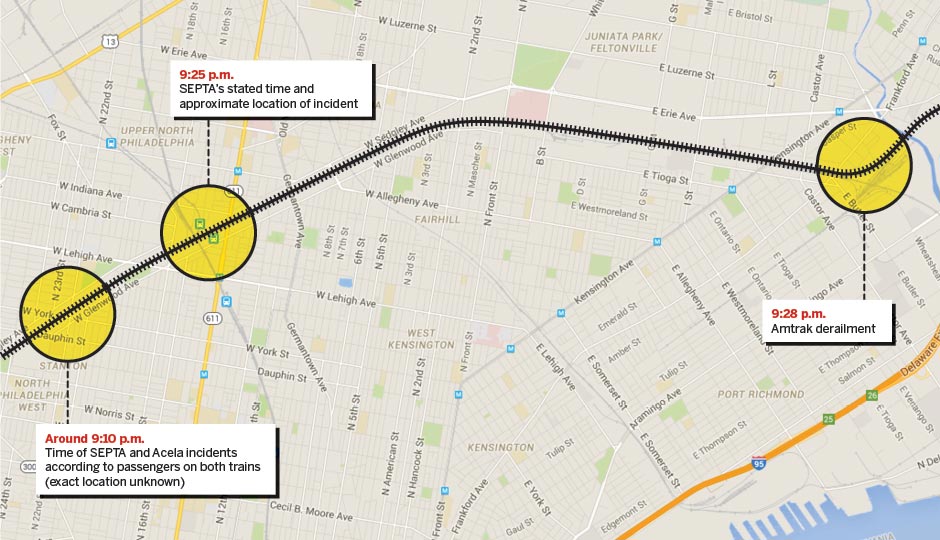SEPTA and Acela Trains Struck Before Amtrak Crash [UPDATED]

Graphic by Jamie Leary, Phillymag.com
UPDATE, 5/13/2015, 3 p.m.: At an afternoon press conference, Philadelphia Mayor Michael Nutter said that the SEPTA and Amtrak Acela trains that were struck within five miles and twenty minutes of the deadly Amtrak derailment are unrelated to the crash. “That may have been stones or rocks,” he responded when asked about reports of projectiles hitting the two trains. “Nothing to do with this particular incident.” Meanwhile, SEPTA has updated the time of its incident from 9:25 p.m. to 9:10 p.m.
ORIGINAL:
SEPTA officials have confirmed that an “unknown projectile” broke the engineer’s window on a SEPTA Regional Rail train on Tuesday night along the same corridor as the deadly Amtrak crash. And according to a passenger on the 8 p.m. Acela train from New York to Philadelphia, that train was struck as well.
According to SEPTA, train number 769 was on its way to Trenton from Philadelphia when an object hit the engineer’s window, breaking it. After the incident was reported, the train was held at the North Philadelphia station.
At 9:28 p.m., Amtrak Northeast Regional Train 188 — en route from Washington to New York on tracks adjacent to the SEPTA rails — derailed, killing at least seven and injuring more than 140, according to officials.
Early on Wednesday morning, a SEPTA spokesperson said the incident with the window occurred at 9:25 p.m., three minutes before the Amtrak crash, as multiple media outlets have reported. But according to Drexel history professor Scott Knowles, who was on the SEPTA train in question, the SEPTA incident occurred earlier than that.
Knowles, author of The Disaster Experts: Mastering Risk in Modern America, tells Philadelphia magazine that he texted his wife at 9:16 p.m. on Tuesday, explaining the problem to her. “My best guess is that it happened at 9:08 p.m.,” he says. “Because we were sitting there for at least a few minutes before they told us what had happened, and then I didn’t text my wife immediately.”
Another SEPTA spokesperson said that the incident occurred at the North Philadelphia station, but Knowles maintains that it occurred somewhere between 30th Street Station and the North Philadelphia Station.
“We had not reached the North Philly station yet,” insists Knowles. “There was some question as to whether they were going to pull us forward to North Philly or send us back to 30th Street.”
When asked for clarification this afternoon, SEPTA spokesperson Jerri Williams said “I based [the timing] on when I got the text from our control center.”
Knowles says that the SEPTA crew was calm and professional and that they told passengers that a SEPTA engineer was covered in glass. Later, he says, the crew informed passengers of the Amtrak derailment.
Meanwhile, Washington resident Madison Calvert says that he was on an Amtrak Acela train from New York to Philadelphia when it was struck by an object, breaking his passenger window. Calvert says that the train left New York a few minutes late and that it was minutes from arriving at Philadelphia’s 30th Street Station when his window shattered.
“It had to be between 9:05 and 9:10,” he says. “It was a pretty big impact. When we arrived at 30th Street, Amtrak cops boarded and took photos of the window.”
Calvert tweeted his own photo of the window:
.@fox5newsdc @FOX29philly @CNN-all very scary.Window shattered on #amtrak 2173 in opposite direction minutes before. pic.twitter.com/FG3gbv1Pna
— Madison Calvert (@MadisonCalvert) May 13, 2015
The National Transportation Safety Board is currently at the site of the Amtrak derailment, and the so-called “black box” has been recovered, says Philadelphia mayor Michael Nutter, who last night called the scene an “absolute, disastrous mess.” The FBI has stated that there is no indication of terrorism in the Amtrak derailment.
According to SEPTA spokesperson Manny Smith, there were no injuries reported on the SEPTA train. The train was taken out of service, and SEPTA deployed buses to transport the passengers. SEPTA has stressed that there is no known connection between the SEPTA incident and the tragic Amtrak derailment.
Follow @VictorFiorillo on Twitter


